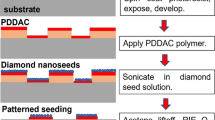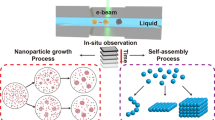Abstract
Drying of colloidal droplets often develops versatile depositions. We study the drying deposition of both colloidal droplets containing silica nanoparticles and the silica colloidal droplets with polyethylene oxide (PEO) additives. We focus on the effect of polymer additives on the deposition formation and the cracking dynamics by using in-situ microscope observation. With PEO additives, a transition from ring-like deposition to uniform deposition is observed, and the cracking dynamics is greatly reduced. The PEO additives enhance the adsorption of particles at the air-water interface, thus forming the network structure at the interface which blocks the outward capillary flow. This contributes to the uniform deposition. Meanwhile, the multi-distribution of the aggregates size enhances the non-homogeneity of the drying film and consequently results in multi-nucleation of cracks. This reduces the stress accumulation that drives the crack propagation and may be responsible for the sluggish cracking dynamics.
Similar content being viewed by others
References
Kajiya T, Doi M. Dynamics of drying process of polymer solution droplets: Analysis of polymer transport and control of film profiles. J Soc Rheol Jpn, 2011, 39: 17–28
Kuncicky D M, Velev O D. Surface-guided templating of particle assemblies inside drying sessile droplets. Langmuir, 2008, 24: 1371–1380
Sirringhaus H, Kawase T, Friend R H, et al. High-resolution inkjet printing of all-polymer transistor circuits. Science, 2000, 290: 2123–2126
Huang J, Kim F, Tao A R, et al. Spontaneous formation of nanoparticle stripe patterns through dewetting. Nat Mater, 2005, 4: 896–900
Kinge S, Crego-Calama M, Reinhoudt D N. Self-assembling nanoparticles at surfaces and interfaces. ChemPhysChem, 2008, 9: 20–42
Deegan R D, Bakajin O, Dupont T F, et al. Capillary flow as the cause of ring stains from dried liquid drops. Nature, 1997, 389: 827–829
Yunker P J, Still T, Lohr M A, et al. Suppression of the coffee-ring effect by shape-dependent capillary interactions. Nature, 2011, 476: 308–311
Hu H, Larson R G. Marangoni effect reverses coffee-ring depositions. J Phys Chem B, 2006, 110: 7090–7094
Cui L, Zhang J, Zhang X, et al. Suppression of the coffee ring effect by hydrosoluble polymer additives. ACS Appl Mater Interfaces, 2012, 4: 2775–2780
Jing G Y, Ma J. Formation of circular crack pattern in deposition self-assembled by drying nanoparticle suspension. J Phys Chem B, 2012, 116: 6225–6231
Adelung R, Aktas O C, Franc J, et al. Strain-controlled growth of nanowires within thin-film cracks. Nat Mater, 2004, 3: 375–379
Brutin D, Sobac B, Loquet B, et al. Pattern formation in drying drops of blood. J Fluid Mech, 2011, 667: 85–95
Pauchard L, Adda-Bedia M, Allain C, et al. Morphologies resulting from the directional propagation of fractures. Phys Rev E, 2003, 67: 027103
Goehring L, Clegg W J, Routh A F. Wavy cracks in drying colloidal films. Soft Matter, 2011, 7: 7984–7987
Lazarus V, Pauchard L. From craquelures to spiral crack patterns: Influence of layer thickness on the crack patterns induced by desiccation. Soft Matter, 2011, 7: 2552–2559
Sendova M, Willis K. Spiral and curved periodic crack patterns in sol-gel films. Appl Phys A, 2003, 76: 957–959
Néda Z, Leung K, Józsa L, et al. Spiral cracks in drying precipitates. Phys Rev Lett, 2002, 88: 095502
Tirumkudulu M S, Russel W B. Role of capillary stresses in film formation. Langmuir, 2004, 20: 2947–2961
Singh K B, Tirumkudulu M S. Cracking in drying colloidal films. Phys Rev Lett, 2007, 98: 218302
Lee W P, Routh A F. Why do drying films crack? Langmuir, 2004, 20: 9885–9888
Chiu R C, Garino T J, Cima M J. Drying of granular ceramic films, I: Effect of processing variables on cracking behavior. J Am Ceram Soc, 1993, 76: 2257–2264
Xu P, Mujumdar A S, Yu B. Drying-induced cracks in thin film fabricated from colloidal dispersions. Drying Technol, 2009, 27: 636–652
Brinker C J, Scherer G W. Sol-GEL SCIEnce: The Physics and Chemistry of Sol-Gel Processing. New York: Academic, 1990
Routh A F, Russel W B. A process model for latex film formation: Limiting regimes for individual driving forces. Langmuir, 1999, 15: 7762–7773
Tirumkudulu M S, Russel W B. Cracking in drying latex films. Langmuir, 2005, 21: 4938–4948
Dufresne E R, Stark D J, Greenblatt N A, et al. Dynamics of fracture in drying suspensions. Langmuir, 2006, 22: 7144–7147
Man W, Russel W B. Direct measurements of critical stresses and cracking in thin films of colloid dispersions. Phys Rev Lett, 2008, 100: 198302
Pauchard L, Elias F, Boltenhagen P, et al. When a crack is oriented by a magnetic field. Phys Rev E, 2008, 77: 021402
Kanai T, Sawada T. New route to produce dry colloidal crystals without cracks. Langmuir, 2009, 25: 13315–13317
Qiao J Q, Adams J, Johannsmann D. Addition of halloysite nanotubes prevents cracking in drying latex films. Langmuir, 2012, 28: 8674–8680
Deegan R D, Bakajin O, Dupont T F, et al. Contact line deposits in an evaporating drop. Phys Rev E, 2000, 62: 756–765
Zebrowski J, Prasad V, Zhang W, et al. Shake-gels: Shear-induced gelation of laponite—PEO mixtures. Colloids Surf A, 2003, 213: 189–197
Larson R G. Re-shaping the coffee ring. Angew Chem-Int Ed, 2012, 51: 2546–2548
Vella D, Aussillous P, Mahadevan L. Elasticity of an interfacial particle raft. Europhys Lett, 2004, 68: 212–218
Vella D, Ajdari A, Vaziri A, et al. Wrinkling of pressurized elastic shells. Phys Rev Lett, 2011, 107: 174301
Zang D Y, Wang X L, Geng X G, et al. Impact dynamics of droplets with silica nanoparticles and polymer additives. Soft Matter, 2013, 9: 394–400
Author information
Authors and Affiliations
Corresponding author
Rights and permissions
About this article
Cite this article
Zhang, Y., Liu, Z., Zang, D. et al. Pattern transition and sluggish cracking of colloidal droplet deposition with polymer additives. Sci. China Phys. Mech. Astron. 56, 1712–1718 (2013). https://doi.org/10.1007/s11433-013-5280-5
Received:
Accepted:
Published:
Issue Date:
DOI: https://doi.org/10.1007/s11433-013-5280-5




